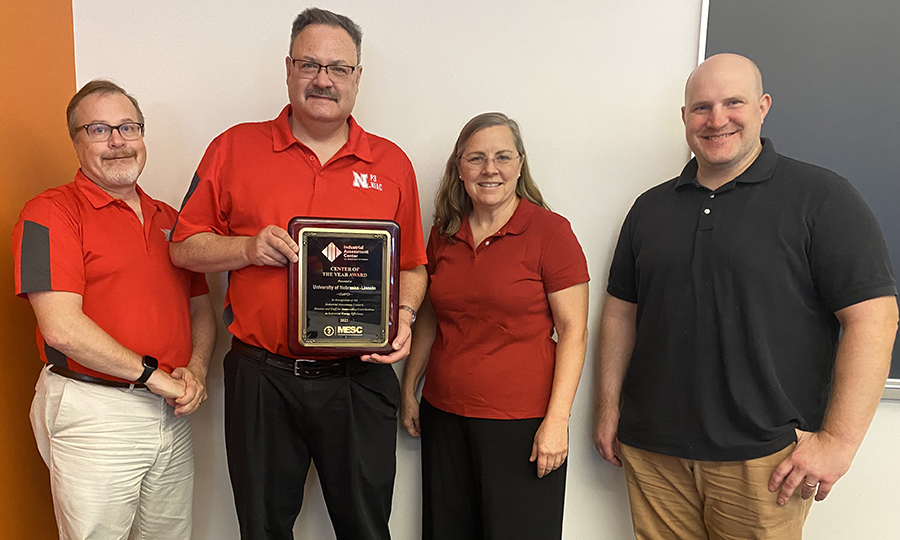Calendar Icon
Sep 05, 2023
Person Bust Icon
By Karl Vogel
![]() RSS
Submit a Story
RSS
Submit a Story

The Nebraska Industrial Assessment Center (NIAC), which since 2017 has helped over 80 small- and medium-sized manufacturers save more than $8.7 million on energy costs and provided engineering experience to nearly 100 students, was chosen by the U.S. Department of Energy as its 2023 IAC of the Year.
One of 39 Industrial Assessment Centers (IACs) at colleges and universities across the United States, the NIAC serves clients in six states: Nebraska, Iowa, Minnesota, South Dakota, Kansas and Missouri. According to the IAC Database, NIAC’s 80 assessments – all of which are free to the clients – have resulted in an average of $109,341 in recommended yearly energy savings to those manufacturers.
“There have been many other IACs that have been doing this much longer than us, so it’s a great honor to be chosen for this award,” said Robert Williams, NIAC director and professor of mechanical and materials engineering. “It recognizes the hard work that the directors and the students put into this effort going back over 10 years, even before the NIAC began.”
“The NIAC really involves teaching students about energy engineering, providing significant outreach in greater Nebraska and neighboring states, and helping the small-to-medium-sized manufacturer save money by lowering energy usage and reducing their carbon footprint,” Williams said.
Currently, the NIAC has three College of Engineering faculty directors – Williams, Bruce Dvorak and Karen Stelling – and a staff of 12 undergraduate and graduate students. Over the six years NIAC has been operating, 79 students have been part of the center.
“We have long focused on developing our undergraduate students’ skills and on including as many students as possible,” said Dvorak, the Ray Fauss Professor of Civil and Environmental Engineering.
“Ultimately, the hands-on experience is invaluable for students – learning how to work with real clients and sometimes incomplete datasets and creating and communicating recommendations. Our long hours on the road and late nights reviewing reports have been recognized.”
Typically, teams comprised of five or six students and one or two IAC directors perform on-site assessments at manufacturing companies with gross annual sales of less than $100 million, fewer than 500 employees, and annual energy bills of between $100,000 and $3.5 million. These assessments include analyses of yearly utility bills, systems and practices, and equipment.
After a one-day site tour, the NIAC team formulates plans and begin the process of making formal recommendations in a final report sent to the manufacturer within 60 days of the assessment. Over the next calendar year, the NIAC team follows up with the client to check on implementation of their recommendations. NIAC has found that about 60 percent of its recommendations have been implemented.
“This award shows that the NIAC consistently delivers,” said Stelling, professor of practice in mechanical and materials engineering. “One of the top priorities is the development of the students and their understanding the systems through hands-on experience. These skills are highly desirable to employers.”
That development includes creating engineering coursework concerning assessing energy and water use, waste production, and approaches to improve the manufacturing processes based on the data collected. This coursework includes a new class that required by all new NIAC students. These classes draw students from multiple degree programs throughout the College of Engineering.
Dvorak said the help NIAC provides to the businesses and people of Nebraska is also due to the partnerships with many entities across the state, including Lincoln Electric System, Nebraska Public Power District, Omaha Public Power District, the Nebraska Department of Environment and Energy, and UNL’s Nebraska Manufacturing Extension Partnership.
Many of those relationships were forged two decades earlier when Dvorak’s P3: Partners in Pollution Prevention program began. In P3, undergraduate students perform waste assessments and make waste and resource reduction recommendations to businesses as part of a summer-long internship where a student focuses on one partner. Partners range from medium-sized food processors to large manufacturing plants, and even include agricultural producers.
From running P3 and working under several other DOE grants, Dvorak said, came valuable experience that made the NIAC operate smoothly in its first few years.
The NIAC was asked to partner with Oklahoma State University to create the Great Plains Center of Excellence within the IAC program. Williams said this center – which will provide a greater pool of resources to draw from and help NIAC expand its reach into Iowa, Minnesota and South Dakota – should be operational soon.
The U.S. Department of Commerce created the IAC program in 1976 in response to the oil embargo and rising energy costs. The program specifically focuses on helping small- and medium-sized manufacturing facilities become more efficient in their energy usage and, thereby, cut energy costs.
The IAC program was moved to the DOE when it was formed in 1978, and has since been expanded to include evaluations of inefficient production and facility operations, excess waste pollution, cybersecurity issues, smart manufacturing technologies and comprehensive energy management systems.
Submit a Story